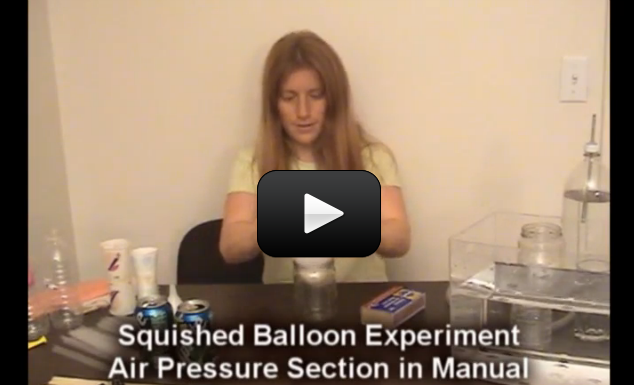Fire eats air, or in more scientific terms, the air gets used up by the flame and lowers the air pressure inside the jar. The surrounding air outside the jar is now at a higher pressure than the air inside the jar and it pushes the balloon into the jar. Remember: Higher pressure pushes!
Materials: a balloon, one empty glass jar, scrap of paper towel , matches with an adult
Please login or register to read the rest of this content.


It worked out perfectly!
My kids loved it!
Any size really… I’ve done it with soda bottles as well as mayo jars.
what size glass jar?
We found that using very small pieces of paper helped. Even when using a pint sized jar.
Yes, the water trick will keep the balloon from popping – it sounds like your heat source was too close to the balloon. You need something to consume the oxygen so that the balloon gets pushed into the jar. You can use a lighter, but you’ll have a hard time getting it to stay on or shutting it off when the flame extinguishes (if you don’t turn off the lighter, it will seep gas into the chamber and keep the pressure from decreasing).
We did this experiment many times. It worked several times until a balloon popped! That scared us and we had a few more pop. We concluded that maybe we didn’t put the balloon on top fast enough or maybe our balloons were just too old and cheap! Then the kids and I simulatenously thought why not use a lighter? Why do we have to use a match? Well then we ran into many popped balloons and so then we wondered, does it matter if we use a lighter or a match? I just read the comments about putting water in the balloon before blowing up…I will get some balloons and try that out. Does it matter how soon you put in the lit paper towel scrap to when you put on the balloon? And does it matter if you use a match vs. a lighter?
Most likely the heat melted a hole in the balloon. You can add a tablespoon of water into the balloon before blowing it up when you do this experiment again and the balloon won’t pop, no matter how close to the flame you put it.
When we did this, our balloons popped. Our theory is that the heat made the balloon expand to pop it…..or the heat made a hole in the balloon.
You are right. The reaction of the balloon is due to a change in temperature. When air is heated, it tries to expand. This expansion causes the air to take up more space in the container. When the air cools down, it will contract. This contraction creates a difference in pressure between the container and the air on the outside of the container. The balloon responds by being sucked into the container. Just as you said…..very astute of you… Congratulations on being so observant. A true scientist’s brain at work.
On the video when the balloon is pushed into the bottle after the paper is burned, are you sure it is because the air (O2) is eaten? It seems that the CO2 and H2O put out would at least equal the O2 used. I thought it was related to teh change in temperature. As the gas is heated the air pushes the balloon up and the pressure is not affected, but as it cools, the pressure is reduced, the external air pushes the balloon down sealing the flask and pushing the balloon in further. What do you think?